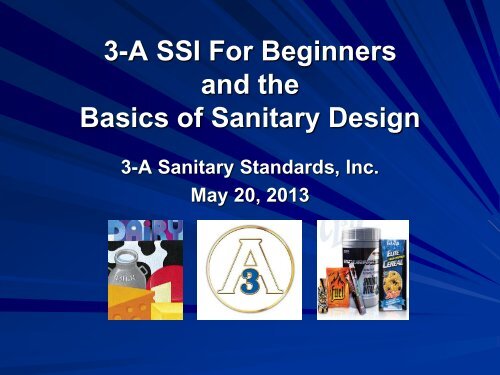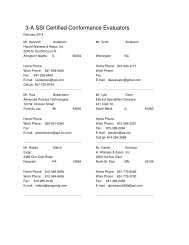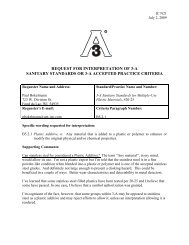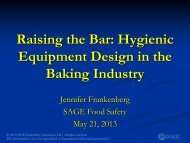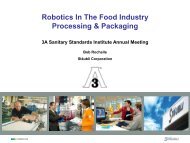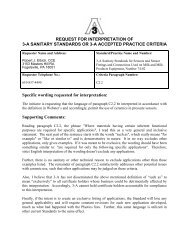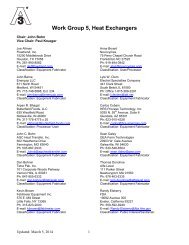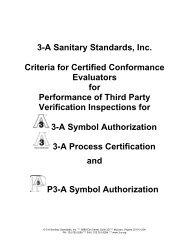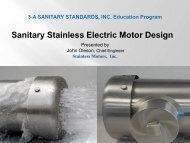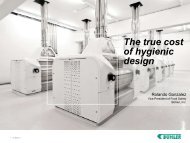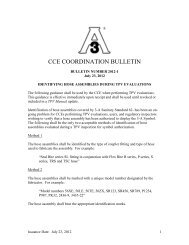Basics of Sanitary Design (PDF) - 3-A Sanitary Standards
Basics of Sanitary Design (PDF) - 3-A Sanitary Standards
Basics of Sanitary Design (PDF) - 3-A Sanitary Standards
Create successful ePaper yourself
Turn your PDF publications into a flip-book with our unique Google optimized e-Paper software.
3-A SSI For Beginners<br />
and the<br />
<strong>Basics</strong> <strong>of</strong> <strong>Sanitary</strong> <strong>Design</strong><br />
3-A <strong>Sanitary</strong> <strong>Standards</strong>, Inc.<br />
May 20, 2013
Welcome!<br />
Lou Beaudette, 3-A SSI Chair<br />
R
Program Chair<br />
Larry Hanson<br />
R
Special Welcome!<br />
Student Travel Award Recipients<br />
R
Student Travel Award Recipients<br />
Yifang Cheng, Cornell University<br />
Emily Harbison, University <strong>of</strong> Wisconsin-<br />
Madison<br />
Yen Te Liao, Texas Tech University<br />
Andrew Scollon, Michigan State University
3-A SSI Executive Director<br />
Tim Rugh
The Schedule<br />
Overview <strong>of</strong> 3-A SSI<br />
<strong>Basics</strong> Part 1<br />
Break<br />
<strong>Basics</strong> Part 2<br />
Wrap Up
And Now…<br />
3-A SSI For Beginners
3-A SSI For Beginners<br />
History and Structure<br />
Key Activities
What is 3-A <strong>Sanitary</strong> <strong>Standards</strong>, Inc.<br />
Not-for-pr<strong>of</strong>it 501 (c) (3) corporation<br />
Represents three stakeholder groups<br />
with a long history <strong>of</strong> collaboration on<br />
sanitary equipment design
Brief History <strong>of</strong> 3-A SSI<br />
1920<br />
First Standard<br />
1944 USPH<br />
Participation<br />
1956<br />
New Symbol<br />
2002<br />
3A-SSI
Before 2002<br />
After 2002<br />
<strong>Standards</strong> Writing-Publishing-TPV-Symbol<br />
Training-Education-Harmonization<br />
3-A <strong>Sanitary</strong> <strong>Standards</strong> Inc.
The 3-A SSI Stakeholders<br />
Regulatory Sanitarians<br />
Processors (Users)<br />
Fabricators<br />
3-A <strong>Sanitary</strong> <strong>Standards</strong>, Inc.
The 3-A SSI Structure<br />
As a non-pr<strong>of</strong>it corporation, 3-A SSI<br />
is governed by Articles <strong>of</strong><br />
Incorporation and Bylaws<br />
Decision making authority is vested<br />
in the Board <strong>of</strong> Directors<br />
Dedicated, independent staff
The 3-A SSI Board <strong>of</strong> Directors<br />
5 Original Founding Member<br />
Organizations (2 representatives <strong>of</strong> each)<br />
–International Dairy Foods Association (IDFA)<br />
–Food Processing Suppliers Association (FPSA)<br />
–International Association for Food Protection (IAFP)<br />
–American Dairy Products Institute (ADPI)<br />
–3-A Symbol Administrative Council (now dissolved)<br />
Chair <strong>of</strong> the 3-A Steering Committee<br />
Chair <strong>of</strong> the P3-A Steering Committee<br />
One USDA and one FDA representative
3-A SSI Board <strong>of</strong> Directors<br />
Officers<br />
• Chair, Lou Beaudette, Admix, Inc.<br />
• Vice Chair, Dan Meyer, ADPI<br />
• Secretary, Ken Anderson, Harold<br />
Wainess Associates<br />
• Treasurer, Carl Buell, Leprino<br />
Foods<br />
Directors<br />
• Warren S. Clark, Jr., Consultant<br />
• Lyle Clem, ESC, 3-A Steering<br />
Committee<br />
• Ray Dyke, Agri-Mark, Inc.<br />
• Larry Hanson, Johnsonville<br />
Sausage, LLC<br />
• Robert F. Hennes, Chief,<br />
FDA/CFSAN-Milk Safety Branch<br />
• Clay Hough, IDFA<br />
• Ronald Schmidt, University <strong>of</strong><br />
Florida<br />
• F. Tracy Schonrock, TPV<br />
Coordinating Committee<br />
• David Seckman, FPSA<br />
• Ken Vorgert, USDA/AMS, Dairy<br />
Grading Branch
The 3-A SSI Staff<br />
Oversees organization activities:<br />
‣ <strong>Standards</strong> Writing and Publishing<br />
‣ Industry Education and Training<br />
‣ Administer <strong>of</strong> 3-A Symbol Licensing<br />
Program<br />
‣ Harmonization and Liaison With<br />
Other Organizations
Mission Objectives<br />
To advance the regulatory goals <strong>of</strong> USDA, FDA,<br />
regional and local agencies through a credible third<br />
party verification program for food processing<br />
equipment and systems.<br />
To promote recognition and adoption <strong>of</strong> 3-A sanitary<br />
design criteria worldwide.<br />
To administer a modern, effective, and efficient<br />
consensus process to develop national standards.<br />
To advance the application <strong>of</strong> 3-A <strong>Sanitary</strong> <strong>Standards</strong><br />
in the processing <strong>of</strong> all comestible products.<br />
To maintain a sound, progressive and respected<br />
organization to serve the evolving interests <strong>of</strong> all<br />
stakeholders in sanitary equipment design and<br />
advance the goal <strong>of</strong> public health.
The 3-A SSI Committees<br />
Communications & Education<br />
Finance Committee<br />
TPV Coordinating Committee<br />
Interpretations Committee<br />
3-A Steering Committee<br />
P3-A Steering Committee
What is the 3-A Symbol<br />
The 3-A Symbol is a licensed mark used<br />
to show the conformity <strong>of</strong> equipment<br />
designed and manufactured<br />
to a 3-A <strong>Sanitary</strong> Standard.
Use <strong>of</strong> the 3-A Symbol<br />
Since introduction <strong>of</strong> the mark in 1956,<br />
use <strong>of</strong> the mark was based on selfcertification.<br />
3-A SSI was created to implement a<br />
new Third Party Verification (TPV)<br />
inspection program for all users <strong>of</strong> the<br />
mark.
Why a New TPV Requirement<br />
TPV brings added assurance that<br />
equipment showing the 3-A symbol fully<br />
conforms to the applicable 3-A <strong>Sanitary</strong><br />
Standard.
The TPV Program in Brief<br />
Verification <strong>of</strong> compliance must be done by<br />
an independent credentialed authority – a<br />
Certified Conformance Evaluator (CCE).<br />
TPV certification performed via agreement<br />
between CCE and Symbol holder.<br />
Scope <strong>of</strong> TPV program and CCE<br />
credentialing set by 3-A SSI.
How a TPV is Done<br />
The Symbol Holder or applicant contracts<br />
with a CCE to do a TPV.<br />
The CCE reviews drawings, bills <strong>of</strong><br />
material, material certificates, and<br />
compares to the 3-A <strong>Sanitary</strong> Standard.<br />
The CCE inspects an actual piece <strong>of</strong><br />
finished equipment—checks radii, surface<br />
finish, welds, etc.<br />
The CCE inspects the fabrication plant—<br />
on site visit is required.<br />
The CCE reviews EDTCF, Quality program,<br />
instruction manuals, etc.
How a TPV is Done<br />
The CCE issues a report and certificate <strong>of</strong> the<br />
TPV with 4 copies:<br />
– One to the 3-A SSI Office<br />
– Two to the Fabricator, one to send to 3-A<br />
SSI and the other for their file.<br />
– One for the CCE files<br />
The TPV Report follows the language <strong>of</strong> the<br />
standards.<br />
The TPV is good for 5 years unless<br />
significant design changes or Report <strong>of</strong><br />
Alleged Nonconformance.
Qualifications <strong>of</strong> a CCE<br />
Must meet specific criteria for education and<br />
work experience.<br />
Must have high pr<strong>of</strong>essional integrity.<br />
Must pass comprehensive written exam.<br />
Must undergo special CCE orientation and<br />
ongoing training.
TPV Inspection Sites<br />
Argentina<br />
Austria<br />
Australia<br />
Belgium<br />
Brazil<br />
Canada<br />
China<br />
Denmark<br />
England<br />
Finland<br />
France<br />
Germany<br />
Israel<br />
Italy<br />
Japan<br />
Korea<br />
Mexico<br />
Netherlands<br />
New Zealand<br />
Poland<br />
Portugal<br />
Russia<br />
Spain<br />
Sweden<br />
Switzerland<br />
Taiwan<br />
Thailand
TPV Inspection Services<br />
Required for 3-A Symbol licensing<br />
Necessary for other voluntary<br />
certificate programs:<br />
‣Replacement Parts & System Component<br />
Qualification Certificate<br />
‣3-A Process Certification<br />
‣P3-A Symbol authorization
The Role <strong>of</strong> 3-A SSI in Commerce<br />
USDA – General Specifications for Dairy<br />
Plants Approved for USDA Inspection<br />
and Grading Service<br />
All new, replacement or modified<br />
equipment and all processing systems,<br />
cleaning systems, utensils, or<br />
replacement parts shall comply with the<br />
most current, appropriate 3-A <strong>Sanitary</strong><br />
<strong>Standards</strong> or 3-A Accepted Practices.
The Role <strong>of</strong> 3-A SSI in Commerce<br />
USPHS/FDA Pasteurized Milk<br />
Ordinance (PMO)<br />
Equipment manufactured in<br />
conformity with 3-A <strong>Sanitary</strong><br />
<strong>Standards</strong> complies with the sanitary<br />
design and construction standards <strong>of</strong><br />
this Ordinance.
The Consensus Process<br />
How Does 3-A SSI Develop Documents
The Consensus Process<br />
3-A SSI is an ANSI-accredited <strong>Standards</strong><br />
Developer Organization (SDO)<br />
3-A <strong>Sanitary</strong> <strong>Standards</strong><br />
3-A Accepted Practices<br />
P3-A <strong>Standards</strong>
Consensus Process - Overview<br />
Management<br />
3-A Steering<br />
Committee<br />
Development<br />
Work Group Work Group Work Group<br />
Approval<br />
Canvass Group
<strong>Basics</strong> <strong>of</strong> <strong>Sanitary</strong> <strong>Design</strong><br />
Gabe Miller
<strong>Basics</strong> <strong>of</strong> <strong>Sanitary</strong> <strong>Design</strong><br />
Part 1
What is a 3-A <strong>Sanitary</strong> Standard<br />
3-A <strong>Sanitary</strong> <strong>Standards</strong><br />
specify the criteria for the<br />
design and fabrication <strong>of</strong><br />
a specific type <strong>of</strong><br />
equipment that comes<br />
into contact with food.
3-A <strong>Sanitary</strong> <strong>Standards</strong><br />
Vessels<br />
Fillers<br />
Valves and Fittings<br />
Pumps and Mixers<br />
Heat Exchangers<br />
Conveyors and<br />
Feeders<br />
Instruments<br />
Concentrating<br />
Equipment<br />
Farm/Raw Milk<br />
Cheese and Butter<br />
Equipment<br />
Materials and<br />
Materials Testing
What is a 3-A Accepted Practice<br />
3-A Accepted Practices specify the<br />
criteria for the design, fabrication and<br />
installation <strong>of</strong> systems that come into<br />
contact with food.
3-A Accepted Practices<br />
Process and Cleaning Systems<br />
– HTST and HHST Pasteurizer Systems (603-)<br />
– Permanently Installed Product and Solution<br />
Pipelines and Cleaning Systems (605-)<br />
– CIC <strong>of</strong> Crossflow Membrane Processing Systems<br />
(610-)<br />
– Spray Drying (607-) and Instantizing (608-)<br />
– DFI <strong>of</strong> Milking & Milk Handling Equipment (606-)<br />
– Farm Milk Cooling & Storage (611-)<br />
Plant Support Systems<br />
– Air Under Pressure for Product Contact (604-)<br />
– Steam <strong>of</strong> Culinary Quality (609-)<br />
– Plant Environmental Air Quality (612-)
How They Work Together
Seven Common Elements <strong>of</strong> 3-A <strong>Sanitary</strong><br />
<strong>Standards</strong> and Accepted Practices<br />
1) Scope <strong>of</strong> the Standard<br />
2) Normative References<br />
3) Definition <strong>of</strong> Terms Used<br />
4) Description <strong>of</strong> Permitted Materials<br />
5) Details <strong>of</strong> Fabrication<br />
6) Appendix<br />
7) Installation
Scope<br />
Amplifies the Title to differentiate this<br />
document from all others.<br />
Build a box around what the document<br />
covers.<br />
Clearly identify the inlets and outlets<br />
May state what the document doesn’t<br />
cover
Normative References<br />
B1 The following listed 3-A <strong>Sanitary</strong><br />
<strong>Standards</strong>, 3-A Accepted Practices and<br />
other documents shall be considered as<br />
Normative References and the provisions <strong>of</strong><br />
the referenced documents shall apply to<br />
this Standard {or Accepted Practice}<br />
without further reference in this document<br />
unless necessary to describe special<br />
considerations.
Definitions<br />
To define special or unusual terms<br />
used in the document.<br />
Definitions not used in the document<br />
should not be included.<br />
As appropriate, new definitions can be<br />
created.
Product Contact Surfaces: All surfaces which are exposed to<br />
the product and surfaces from which splashed product, liquids<br />
or material may drain, drop, diffuse {Where Applicable}, or be<br />
drawn into the product or onto product contact surfaces.<br />
{Surfaces That Come Into Contact With Product Contact<br />
Surfaces Of Packaging Materials May Be Included In This<br />
Definition For Some Equipment.}<br />
Nonproduct Contact Surfaces: All exposed surfaces from<br />
which splashed product, liquids, or other materials cannot<br />
drain, drop, diffuse {Where Applicable} or be drawn into or<br />
onto the product, product contact surfaces, open packages, or<br />
the product contact surfaces <strong>of</strong> package components.
Cleaning Definitions<br />
Clean-in-Place (CIP)<br />
Clean-Out-<strong>of</strong>-Place (COP)<br />
Manual Cleaning<br />
Dry Cleaning
Materials<br />
To identify what materials can be<br />
used to fabricate the equipment.<br />
Product Contact Surfaces<br />
– Metals<br />
– Nonmetals<br />
Nonproduct Contact Surfaces
Product contact surfaces shall be <strong>of</strong> stainless steel <strong>of</strong> the<br />
American Iron and Steel Institute (AIST) 300 Series, excluding<br />
301, 302, and 303, (Refer to B4, Reference No. 5) or<br />
corresponding Alloy Cast Institute (ACI) types (Refer to B4,<br />
Reference No. 6) or metal which under conditions <strong>of</strong> intended use<br />
is at least as corrosion resistant as 304 stainless steel, and is<br />
nontoxic and nonabsorbent. (Refer to Appendix, Section H.)<br />
Where welding is involved, the carbon content <strong>of</strong> the stainless<br />
steel shall not exceed 0.08%.<br />
Rubber and rubber-like materials may be used for {All Required<br />
Application(s) Including Coatings} and when used for the<br />
specified application(s), shall conform to the applicable provisions<br />
<strong>of</strong> 3-A <strong>Sanitary</strong> Standard, Number 18-.<br />
Plastic materials may be used for {All Required Application(s)<br />
Including Coatings} and when used for the above-specified<br />
application(s), shall conform to the applicable provisions <strong>of</strong> 3-A<br />
<strong>Sanitary</strong> Standard, Number 20- .
Fabrication<br />
Equipment is to be designed to be 100%<br />
cleanable.<br />
The design must preclude<br />
contamination <strong>of</strong> the product.<br />
Fabrication to 3-A criteria DOES NOT<br />
automatically imply compatibility with<br />
CIP cleaning methods.<br />
Illustrations are not to be interpreted as<br />
engineering drawings.
Appendix<br />
Generally considered as informational<br />
or advisory.<br />
“Should” is the term used.
Appendix Sections<br />
Stainless Steels<br />
Optional Metal Alloys<br />
Product Contact Surface Finish<br />
Air Venting<br />
Engineering <strong>Design</strong> and Technical<br />
Construction File (EDTCF)
Installation<br />
This is an optional section.<br />
This may be in the body <strong>of</strong> the<br />
document or as part <strong>of</strong> the appendix.<br />
Provides guidance for proper<br />
installation.
Break
<strong>Basics</strong> <strong>of</strong> <strong>Sanitary</strong> <strong>Design</strong><br />
Part 2<br />
Pump Evaluation, 02-10
Centrifugal Pump<br />
Evaluation
While Disassembled –<br />
All Radii Can Be Measured<br />
Agreement with Drawings Verified<br />
Exposure <strong>of</strong> Seals Verified<br />
Surface Finishes Verified<br />
General Suitability Confirmed<br />
Nonproduct Contact Matls Checked<br />
Agreement with Documentation
While Disassembled –<br />
CCE Checklist Completion<br />
Marking <strong>of</strong> Standard Performed<br />
Material Options Verified<br />
Understanding <strong>of</strong> QC Process<br />
Confirm Any Special User Guidance<br />
Reassembly Instructions Verified<br />
Facility Review and QC Verified
D1 Surface Finish<br />
D1.1 All product contact surfaces shall<br />
have a finish at least as smooth as a No.<br />
4 ground finish on stainless steel sheets<br />
and be free <strong>of</strong> imperfections such as pits,<br />
folds and crevices in the final fabricated<br />
form.
D2 Permanent Joints<br />
D2.1 All permanent joints in metallic<br />
product contact surfaces shall be<br />
continuously welded. Welded areas<br />
on product contact surfaces shall be<br />
at least as smooth as a No. 4 ground<br />
finish on stainless steel sheets, and<br />
be free <strong>of</strong> imperfections such as pits,<br />
folds, and crevices when in the final<br />
fabricated form except that:<br />
D2.1.1 In such cases where welding<br />
is impractical, soldering, press-fitting<br />
or shrink-fitting may be employed<br />
where necessary for essential<br />
functional reasons such as<br />
bushings, internal bearings, pins and<br />
mechanical seal components. (See<br />
Appendix, Section E7.)<br />
D2.1.2 Silver bearing solder may<br />
be used around pins for sealing<br />
joints and producing fillets for<br />
minimum radii.<br />
D2.1.3 Press-fitting, shrink-fitting or<br />
soldering shall produce product<br />
contact surfaces which are at least<br />
as smooth as a No. 4 ground finish<br />
on stainless steel sheets which are<br />
free <strong>of</strong> imperfections such as pits,<br />
folds and crevices. (See Appendix,<br />
Section E6.)
D3 Coatings<br />
D3.1 Coatings, if used, shall be free<br />
from surface delamination, pitting,<br />
flaking, spalling, blistering and<br />
distortion when exposed to the<br />
conditions encountered in the<br />
environment <strong>of</strong> intended use and in<br />
cleaning and bactericidal treatment or<br />
sterilization.
D4 Cleaning<br />
D4.1 Centrifugal and positive rotary pumps that are to<br />
be mechanically cleaned shall be designed so that<br />
the product contact surfaces <strong>of</strong> the pump and all<br />
nonremoved appurtenances thereto can be<br />
mechanically cleaned and are easily accessible and<br />
readily removable for inspection.<br />
D4.2 Product contact surfaces not designed to be<br />
mechanically cleaned shall be easily accessible for<br />
cleaning and inspection when in an assembled<br />
position or when removed. Demountable parts shall<br />
be readily removable.
D5 Draining<br />
D5.1 All product contact surfaces shall be<br />
drainable when disassembled.<br />
From EHEDG Doc. 10<br />
(modified)
D6 Fittings<br />
D6.1 All sanitary fittings and connections shall<br />
conform to the 3-A <strong>Sanitary</strong> <strong>Standards</strong> for<br />
<strong>Sanitary</strong> Fittings for Milk and Milk Products,<br />
Number 63- .<br />
D6.2 Rectangular flanges or round flange-type<br />
fittings may be used for specific applications<br />
such as connectors to hoppers or feeders.
D7 Seals<br />
D7.1 The shaft seal(s) shall be<br />
sanitary in design with all product<br />
contact parts demountable and<br />
accessible for inspection or cleaning,<br />
and shall not be <strong>of</strong> the packing type.
D8 Gaskets<br />
D8.1 Gaskets having a product contact surface shall be<br />
removable or bonded.<br />
D8.2 Grooves in gaskets shall be no deeper than their<br />
width.<br />
D8.3 Gasket retaining grooves in product contact surfaces<br />
for removable gaskets shall not exceed 1/4 in. (6.35 mm)<br />
in depth or be less than 1/4 in. (6.35 mm) wide except<br />
those for standard 0-rings smaller than 1/4 in. (6.35 mm),<br />
and those provided for in Section D6.1.<br />
D8.4 Gaskets, when used, shall be self positioning and<br />
form a substantially flush interior joint.
D9 Radii<br />
D9.1 All internal angles <strong>of</strong> less than<br />
135° on product contact surfaces<br />
shall have radii <strong>of</strong> not less than 1/8<br />
in. (3.18 mm) except that:<br />
D9.1.1 Smaller radii may be used<br />
when they are required for essential<br />
functional reasons, such as those in<br />
seal components; slots in the heads<br />
<strong>of</strong> impeller or rotor retaining<br />
fasteners; and rotor-to-body<br />
clearance areas. In no case shall<br />
such radii be less than 1/32 in.<br />
(0.794 mm) except that:<br />
D9.1.1.1 The radius at the<br />
intersection <strong>of</strong> press-fits, shrink-fits<br />
and flat sealing surfaces is zero by<br />
nature <strong>of</strong> the design and definition <strong>of</strong><br />
this type <strong>of</strong> fabrication.<br />
D9.1.2 The radii in grooves in<br />
gaskets or gasket retaining<br />
grooves shall be not less than 1/16<br />
in. (1.59 mm), except for those for<br />
standard 1/4 in. (6.35 mm) and<br />
smaller O-rings and those<br />
provided for in Section D6.1.<br />
D9.1.3 Radii in standard O-ring<br />
grooves shall be as specified in<br />
Appendix E9.<br />
D9.1.4 Radii in nonstandard O-ring<br />
grooves shall be those radii<br />
closest to a standard O-ring as<br />
specified in Appendix E9.
There are no minimum radii requirements for soldered<br />
joints or for the product contact junctures <strong>of</strong> press or<br />
shrink fits.
There are no<br />
minimum radii<br />
requirements for the<br />
product contact<br />
junctures <strong>of</strong> flat<br />
sealing surfaces.
D10 Springs<br />
Coil springs having product contact surfaces shall<br />
have at least 3/32 in. (2 mm) openings between<br />
coils including the ends when it is in a free<br />
position.<br />
D11 Threads<br />
D11.1 There shall be no threads on product<br />
contact surfaces except for holding the impeller or<br />
rotor to the shaft.<br />
D11.2 Shaft threads must conform to one <strong>of</strong> the<br />
following thread specifications:
D11.2.1 Exposed Threads<br />
1. Pumps with exposed shaft threads shall be designed<br />
for manual cleaning.<br />
2. Threads shall conform to Appendix E8.1.<br />
3. Threaded angles shall be not less than 60°.<br />
4. There shall not be more than 8 threads per in. (25.<br />
mm).<br />
5. The nut shall be <strong>of</strong> the open type.<br />
6 The length <strong>of</strong> the nut shall not exceed three-fourths <strong>of</strong><br />
the thread’s basic diameter.
ACME Thread
American Standard Stub Acme Thread
D11.2.2 Enclosed Threads<br />
D11.2.2.1 Pumps with enclosed shaft<br />
threads shall be designed for mechanical<br />
cleaning.<br />
D11.2.2.2 These are threads that have<br />
been sealed from the product by means <strong>of</strong><br />
an O-ring, gasket or similar type seal. The<br />
seal shall have controlled compression by<br />
means <strong>of</strong> a positive stop.<br />
D11.2.2.2.1 This controlled compression<br />
shall provide a seal which has been<br />
validated to demonstrate that there is no<br />
migration past the seal under the intended<br />
conditions <strong>of</strong> use.<br />
D11.2.2.2.1.1 The European Hygienic<br />
Engineering and <strong>Design</strong> Group (EHEDG)<br />
test for bacterial tightness is an acceptable<br />
method <strong>of</strong> determining migration past the<br />
seal. Other equally effective tests may be<br />
used as well.<br />
D11.2.2.2.1.2 The manufacturer will provide seal<br />
replacement procedures that will ensure<br />
bacterial tightness as specified in D11.2.2.2.1.1,<br />
above.<br />
D11.2.2.3 Thread specifications are designated<br />
by the manufacturer.<br />
D11.2.2.4 Bolts, screws or nuts may be used for<br />
rotor or impeller retention.<br />
D11.2.2.4.1 If a nut is used, it shall be <strong>of</strong> the<br />
enclosed type.<br />
D11.2.2.4.2 If slotted fasteners are used, the<br />
slot(s) shall meet the criteria <strong>of</strong> Section D9,<br />
Radii, and the slot(s) shall be not less than 1/8<br />
in. wide and no deeper than 2-½ times their<br />
width and shall be inspectable.<br />
D11.2.2.4.3 The seal shall be designed so it is<br />
capable <strong>of</strong> being maintained bacterially tight.<br />
The manufacturer will provide user guidance for<br />
inspection, maintenance, and replacement <strong>of</strong> the<br />
seal as justified by historical data or scientific<br />
evidence.<br />
D11.2.2.5 Enclosed threads shall be cleanable<br />
and drainable. The manufacturer will also<br />
provide validated cleaning procedures, should<br />
the area behind the seal become soiled.
D12 Bonded Parts<br />
D12.1 Pump impellers, rotors, stators or housings may be made <strong>of</strong>,<br />
covered with or bonded with rubber, rubber-like or plastic materials.<br />
D12.2 Housing liners shall be removable or bonded.<br />
D12.3 Bonded rubber and rubber-like materials and bonded plastic<br />
materials having product contact surfaces shall be bonded in a<br />
manner that the bond is continuous and mechanically sound so that<br />
when exposed to the conditions encountered in the environment <strong>of</strong><br />
intended use and in cleaning and bactericidal treatment or<br />
sterilization the rubber and rubber-like material or the plastic material<br />
does not separate from the base material to which it is bonded.<br />
D12.4 Components within seal assemblies may be bonded with<br />
adhesives.
D13 Sterilization Systems<br />
D13.1 Pumps designed to be used in a processing system to<br />
be sterilized by heat shall comply with the following:
D14 Inspectibility<br />
D14.1 A pump shall be designed that (See Appendix,<br />
Section E10):<br />
D14.1.1 The open area between the exterior <strong>of</strong> the<br />
driver or gear case housing to the exterior <strong>of</strong> the<br />
product chamber shall be 1/2 in. (12 mm) minimum<br />
width and <strong>of</strong> sufficient area to allow unrestricted viewing<br />
<strong>of</strong> the pump shaft(s) or seal components at the potential<br />
leak site. This area shall be self-draining.<br />
D14.1.2 At least 1/4 in. (6mm) <strong>of</strong> the shaft(s) exclusive<br />
<strong>of</strong> the seal components shall be visible.<br />
D14.1.3 Guards required by a safety standard that will<br />
not permit accessibility for cleaning and inspection shall<br />
be designed so that they can be removed with the use<br />
<strong>of</strong> simple hand tools.
1. DRIVER OR<br />
GEARCASE<br />
HOUSING<br />
2. DRIVE SHAFT<br />
3. SLINGER<br />
(OPTIONAL)<br />
4. SANITARY SEAL<br />
5. PUMP BODY<br />
6. ½” MINIMUM<br />
7. ¼” MINIMUM
D15 Nonproduct Contact Surfaces<br />
D15.1 Nonproduct contact surfaces shall<br />
have a smooth finish, free <strong>of</strong> pockets and<br />
crevices, and be readily cleanable and<br />
those surfaces to be coated shall be<br />
effectively prepared for coating.
D16 Supports<br />
D16.1 Baseplate Mounted<br />
D16.1.1 A baseplate mounted unit consists <strong>of</strong> some or all <strong>of</strong> the<br />
following components:<br />
1. Pump<br />
2. Motor<br />
3. Mechanical reduction unit such as a gearbox, gearhead drive,<br />
variable speed drive, chain and sprocket system or belt and pulley<br />
system.<br />
4. Pedestal<br />
5. Coupling<br />
6. Guard<br />
7. Baseplate<br />
8. Legs<br />
D16.1.2 The baseplate(s) shall be constructed <strong>of</strong> (a) solid metal<br />
plate(s) or (b) tubular metal that has all open ends sealed by<br />
welding.<br />
D16.1.3 The metal shall be stainless steel or coated or painted mild<br />
steel.
D16.2 Legs<br />
D16.2.1 Legs, when used, shall be<br />
adjustable or fixed with rounded<br />
ends or have flat load bearing feet<br />
suitable for mounting to the floor<br />
and have no exposed threads.<br />
D16.2.2 Legs made <strong>of</strong> hollow stock<br />
shall be sealed.<br />
D16.2.3 Legs shall be <strong>of</strong> sufficient<br />
length to provide a minimum<br />
clearance between the lowest part<br />
<strong>of</strong> the base, pump, motor or drive<br />
and floor no less than 4 in. (100<br />
mm) on pumps with legs designed<br />
to be fixed to the floor or pumps<br />
having a horizontal base area <strong>of</strong><br />
more than 1 ft2 (0.095 m2).<br />
D16.2.4 Legs shall be <strong>of</strong> sufficient<br />
length to provide a minimum clearance<br />
<strong>of</strong> 2 in. (50 mm) on pumps having a<br />
horizontal base area <strong>of</strong> 1 ft2 (0.095<br />
m2) or less and not designed to be<br />
fixed to the floor. Copyright© 3-A<br />
<strong>Sanitary</strong> <strong>Standards</strong>, Inc., McLean,<br />
VA 02-10 7<br />
D16.2.5 If casters or wheels are used<br />
they shall be <strong>of</strong> sufficient size to<br />
provide a clearance between the<br />
lowest part <strong>of</strong> the base and the floor <strong>of</strong><br />
not less than 4 in. (101.6 mm). Casters<br />
or wheels, if provided, shall be easily<br />
cleanable, durable, and <strong>of</strong> a size that<br />
will permit easy movement <strong>of</strong> the<br />
centrifugal or positive rotary pump.
More Details on 3-A SSI<br />
Contact us at:<br />
6888 Elm Street, Suite 2D<br />
McLean, Virginia, 22101<br />
PH: 703-790-0295<br />
FAX: 703-761-6284<br />
Contact Tim Rugh or Philomena Short<br />
trugh@3-a.org, pshort@3-a.org
Visit us at: www.3-a.org
Expanded Knowledge Center<br />
New Video Resources and supplemental<br />
print information available free:<br />
More Than Just a Symbol: The 3-A Story<br />
Essentials <strong>of</strong> <strong>Sanitary</strong> <strong>Design</strong>: The 3-A Format and<br />
Style Manual<br />
The Certified Conformance Evaluator and the TPV<br />
Inspection Overview<br />
Trust But Verify: The TPV Inspection for 3-A Symbol<br />
Authorization<br />
Maintaining 3-A Symbol Integrity: Reporting Alleged<br />
Non-conformance
3-A <strong>Sanitary</strong> <strong>Standards</strong> Are Widely Known<br />
and Used in Many Markets
Questions


